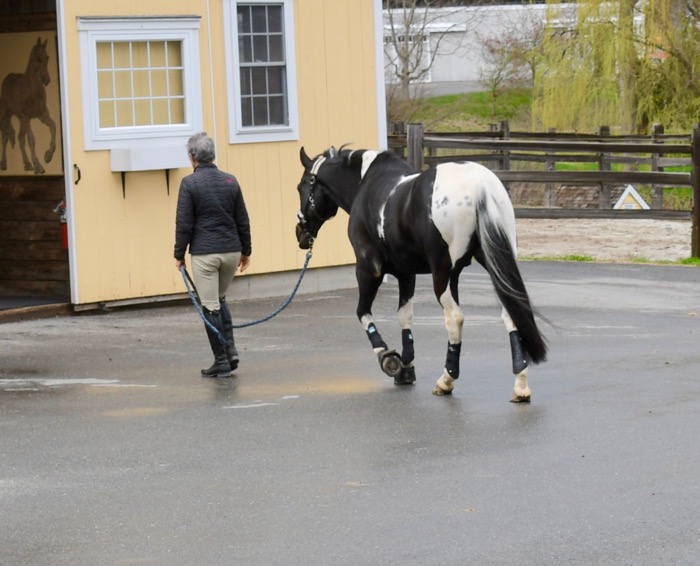If Tonka were a dog, I’d say that he has perfect loose leash walking manners.

Once in awhile, when he lags behind, I gently pull on his halter and he catches up. He doesn’t drag me to grass – he knows graze, head up and let’s go behaviors, which he waits for. I taught all of those using the principles of clicker training. (Break down the task into small increments and reward each step to the final goal.)
When Tonka is hesitant to move forward because he’s worried about what’s up ahead, I ask him to touch my hand. This has been generously rewarded, so that my palm has become a safe place, and gently reaching his nose to it is something he’s almost always eager to do.

This is called target training. You can teach a horse to go to and touch anything. Some people teach their horses to go up to what spooks them and touch it with their nose, which earns a food reward. I don’t do this. I don’t think it’s a good idea. I don’t want my horse approaching dangerous (and often hot) farm machinery. On trail rides, the scary thing is usually deep in the woods, and I don’t want him stepping off of the trail. Or, the scary thing might be moving – wild turkeys!
I have a perfect example.
This is the path that Tonka walks daily to get to his paddock.

For three months he’s calmly walked next to me or the barn staff. Suddenly that changed. Not only was he balking near the rhododendron bush, once in the paddock, instead of grazing, he stared intently at something.

Tonka is not a horse that takes flight. He looks. He thinks things through. If he’s thinking, there’s a reason for it. I had no idea what was going on and I wasn’t going to tell him that everything is alright when obviously it wasn’t. A few days prior to when this behavior started, there’d been a bobcat sighting, but that wouldn’t explain his concern at midday. He’s not scared of herons, coyotes, deer or turkey. I was stumped.
Then, last week, after leaving him in the paddock, I saw a tangle of five snakes on the stone wall! One of them was a huge water snake, and it was shedding its skin to get even larger. I didn’t get a photo at that moment, but I went back and found the skin.

Targeting this scary thing would not have been a good idea! Approaching it isn’t a good idea, either. Although this snake isn’t poisonous, it’s known to have a temper. It will not back down and it will bite.
This is why I don’t teach Tonka to nose touch what he’s scared of. Instead, he trusts that I’ll pay attention to what worries him, too. We both look. I reward him for a steady stance. (Not always with food. Often with calm breaths, a touch on the shoulder. Permission to walk away.) If the scary thing is overwhelming, I might have Tonka do a hand target to reorient him to me. I do not ask him to lower his head – Tonka needs to be looking up to be able to see what concerns him. I want him to be a thinking horse – the goal is not to ignore what is scary, but to understand what it is, and to put it in the no problem category.
So far, the snakes still worry Tonka. He spent his first five years in Texas where snakes can be lethal. I think he’s smart to be cautious. I’m also glad that he tells me where they are. But it’s time to stop being alarmist. I’m now teaching Tonka that the best strategy is to walk straight past them. (Look closely, the snake is in the photo.)

What’s the scariest thing that you’ve had to walk your horse past?


Thank you so much for sharing your knowledge. Learning how to be more aware, and rewarding Thoughtfulness is something I’ve been working toward. Also, your point about reorienting Tonka back to you was helpful. I have learned to do this with our young german shepherd that has such a high predator instinct, with “look at me”. Reading your article helps me apply this differently to our horses. Your educational articles have been a tremendous support in assisting me to listen to my horses with greater awareness, patience, and respect.
Thank you for your comment! I’ve applied the “look at me” in my work with several horses. The difference is that I want to see a look AND a moment of relaxation. With a dog, you can ask for attention and redirect to a fun game in the opposite direction. With a horse, I want a look with a calm demeanor, and no expectation of something exciting happening in return!
that was a very informative read thank you for sharing, How do you start?
Thank you for your comment! Each of my posts has been categorized, and if you you look to the right side of the blogpost, you can click on the category that interests you to see my other posts on the same topic. For spooking, click on this: https://cooperativehorse.com/category/etc/
But here’s the short answer: start with teaching a hand touch behavior, which gives you a highly reinforced, safe place for the horse. Training this also opens your communication with the horse, and teaches you to read small messages from the horse (such as a flick of the ear) I’ve written about that here: https://cooperativehorse.com/2017/11/overcoming-fear-with-touch/
Let me know how it goes!
Very informative read. Thank you!